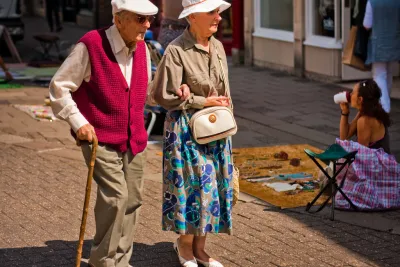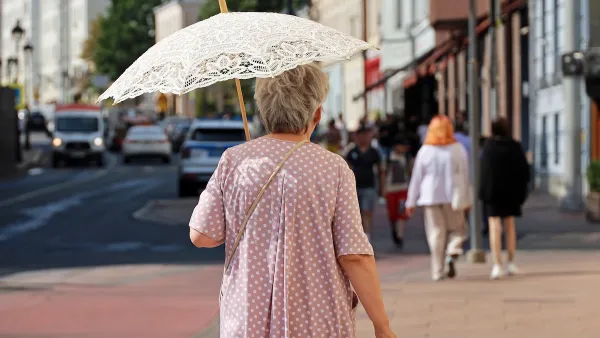The elderly population in cities is growing, and research points to the health benefits of an active, connected lifestyle. So why are cities still so inhospitable to aging?

Anne Karpf writes about why many older people see the city as a hostile place. "Cities are designed for a mythical average person – super-mobile, without dependents or disabilities but with a cast-iron bladder. This person is more likely to be young than old. And yet by 2030, two-thirds of the world's population will be living in cities and, in high-income societies, a quarter of them will be over the age of 60."
Today, that demographic tends to stay in perceived indoor comfort. And that's not good. From the article: "There's a paradox at the heart of cities and old people, and it's this: all the research on health and well-being – and there's reams of it – suggests that old people are more content and more likely to flourish if they go out, participate in local life and have a decent amount of social interaction."
Karpf argues that we perceive aging incorrectly, as an isolated personal "problem" rather than a phase of life with unique public and spatial requirements.
Official overtures to the age-friendly city, says Karpf, often feel like empty sloganeering. But there are many ways cities can open up to old people. "And then I realise that I've been looking in the wrong place – searching for the grand gesture, the sweeping change: age-friendly by government fiat. In reality, age-friendly changes are taking place all around us at the level where most of us live – locally and hyper-locally." The article details several examples of these local changes in action.
FULL STORY: Our cities must undergo a revolution for older people

National Parks Layoffs Will Cause Communities to Lose Billions
Thousands of essential park workers were laid off this week, just before the busy spring break season.

Retro-silient?: America’s First “Eco-burb,” The Woodlands Turns 50
A master-planned community north of Houston offers lessons on green infrastructure and resilient design, but falls short of its founder’s lofty affordability and walkability goals.

Delivering for America Plan Will Downgrade Mail Service in at Least 49.5 Percent of Zip Codes
Republican and Democrat lawmakers criticize the plan for its disproportionate negative impact on rural communities.

Test News Post 1
This is a summary

Test News Headline 46
Test for the image on the front page.

Balancing Bombs and Butterflies: How the National Guard Protects a Rare Species
The National Guard at Fort Indiantown Gap uses GIS technology and land management strategies to balance military training with conservation efforts, ensuring the survival of the rare eastern regal fritillary butterfly.
Urban Design for Planners 1: Software Tools
This six-course series explores essential urban design concepts using open source software and equips planners with the tools they need to participate fully in the urban design process.
Planning for Universal Design
Learn the tools for implementing Universal Design in planning regulations.
EMC Planning Group, Inc.
Planetizen
Planetizen
Mpact (formerly Rail~Volution)
Great Falls Development Authority, Inc.
HUDs Office of Policy Development and Research
NYU Wagner Graduate School of Public Service





























